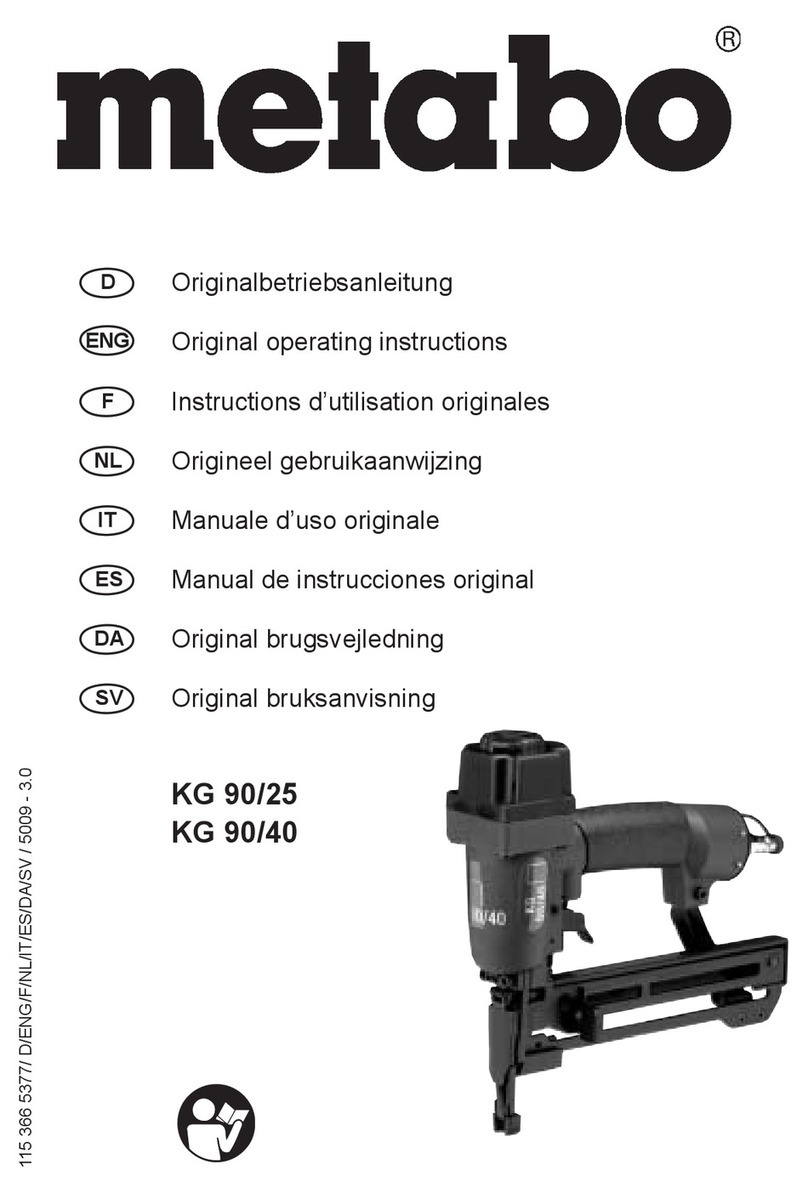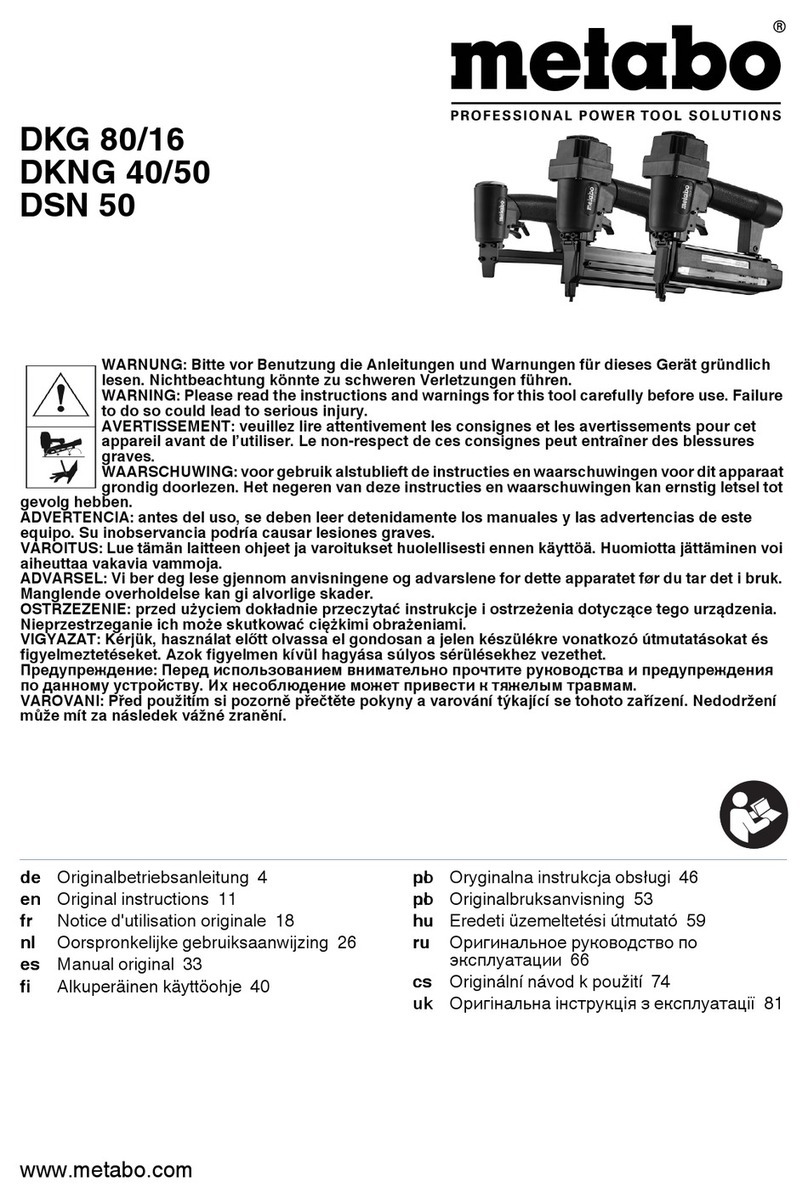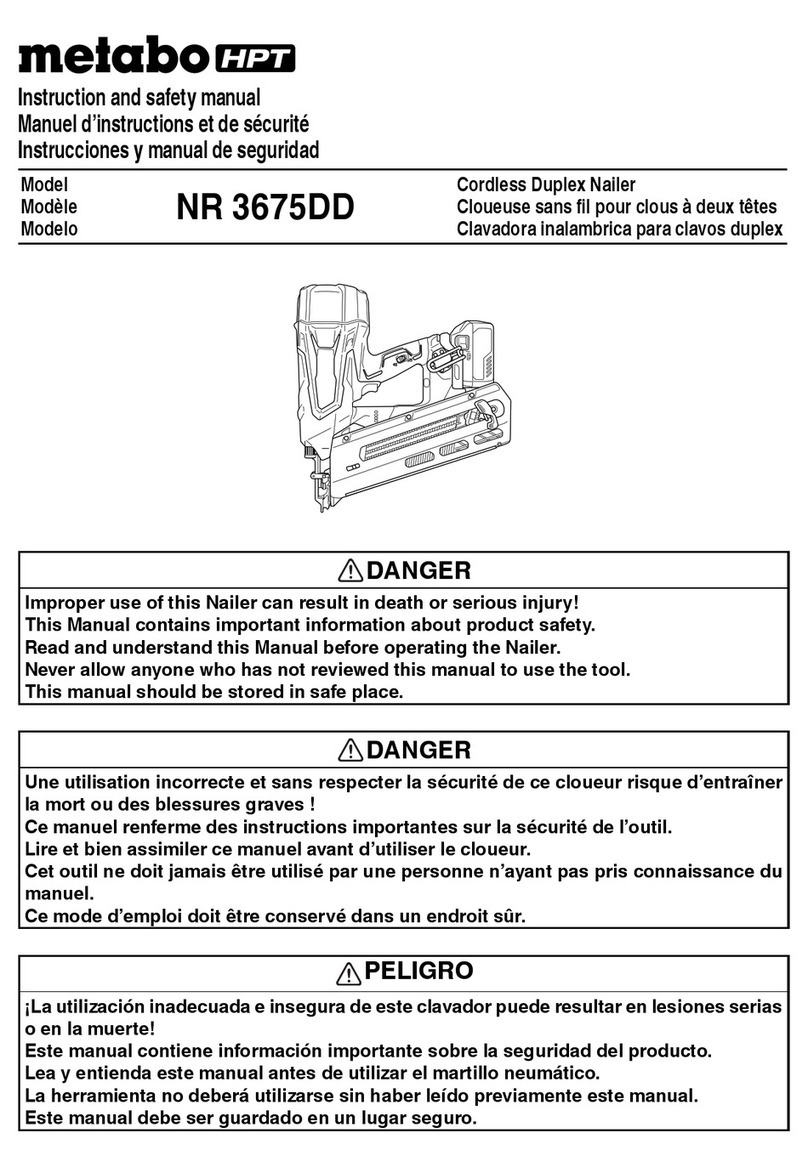
2
English Page Page
Français Page Page
Español Página Página
CONTENTS
TABLE DES MATIÈRES
ÍNDICE
IMPORTANT SAFETY INFORMATION ....................3
DEFINITIONS OF SIGNAL WORDS.........................3
EXPLANATION OF THE NAILING ACTION
OF THE metabo HPT NAILER.............................3
SAFETY
IMPORTANT SAFETY INSTRUCTIONS - FOR
USING NAILERS .................................................4
RESPONSIBILITIES OF EMPLOYER, TOOL
OWNER AND TOOL OPERATOR.......................8
OPERATION
NAME OF PARTS .....................................................9
SPECIFICATIONS................................................... 10
NAIL SELECTION ................................................... 11
ACCESSORIES....................................................... 12
STANDARD ACCESSORIES............................. 12
OPTIONAL ACCESSORIES.............................. 12
APPLICATIONS ...................................................... 12
BEFORE OPERATION............................................ 12
WORKING ENVIRONMENT.............................. 12
AIR SUPPLY ...................................................... 12
LUBRICATION................................................... 13
COLD WEATHER CARE ................................... 13
TESTING THE NAILER ..................................... 13
ADJUSTING AIR PRESSURE........................... 15
LOADING NAILS ............................................... 16
NAILER OPERATION ............................................. 18
METHODS OF OPERATION............................. 19
ADJUSTING THE NAILING DEPTH.................. 21
RAFTER HOOK.................................................22
USING THE NOSE CAP ....................................22
MAINTENANCE
MAINTENANCE AND INSPECTION ......................23
SERVICE AND REPAIRS........................................24
PARTS LIST ............................................................76
INFORMATION IMPORTANTE DE SÉCURITÉ......26
DEFINITION DES MOTS DE SIGNALISATION......26
EXPLICATION DE L’ACTION DE CLOUAGE DU
CLOUEUR metabo HPT ....................................26
SECURITE
CONSIGNES DE SÉCURITÉ IMPORTANTES POUR
L’UTILISATION DU CLOUEUR..........................27
RESPONSABILITÉS DE L’EMPLOYEUR,
DU PROPRIÉTAIRE DE L’OUTIL ET DE
L’OPÉRATEUR DE L’OUTIL...............................31
UTILISATION
NOM DES PIECES..................................................32
SPECIFICATIONS...................................................33
SELECTION DES CLOUS ......................................34
ACCESSOIRES.......................................................35
ACCESSOIRES STANDARD.............................35
ACCESSOIRES EN OPTION ............................35
APPLICATIONS ......................................................35
AVANT L’UTILISATION ...........................................35
ENVIRONNEMENT DE TRAVAIL......................35
ALIMENTATION D’AIR.......................................35
GRAISSAGE......................................................36
ENTRETIEN PAR TEMPS FROID .....................36
ESSAI DU CLOUEUR........................................36
RÉGLAGE DE LA PRESSION D’AIR.................39
CHARGEMENT DES CLOUS............................39
UTILISATION DU CLOUEUR..................................41
MÉTHODES D’UTILISATION............................42
RÉGLAGE DE LA PROFONDEUR DE
CLOUAGE ....................................................45
CROCHET À CHEVRON...................................46
UTILISATION DU CAPUCHON DE BEC...........46
ENTRETIEN
ENTRETIEN ET INSPECTION................................47
ENTRETIEN ET REPARATIONS ............................48
LISTE DES PIÈCES ................................................76
INFORMACIÓN IMPORTANTE SOBRE
SEGURIDAD...................................................... 51
DEFINICIÓN DE LAS PALABRAS CLAVE ............. 51
EXPLICACIÓN LA ACCIÓN DE CLAVADO DEL
CLAVADOR metabo HPT..................................51
SEGURIDAD
INSTRUCCIONES IMPORTANTES DE SEGURIDAD
PARA LA UTILIZACIÓN DEL CLAVADOR........52
RESPONSABILIDADES DEL EMPLEADOR, EL
PROPIETARIO DE LA HERRAMIENTA Y EL
OPERADOR DE LA HERRAMIENTA................56
OPERACIÓN
NOMENCLATURA.................................................. 57
ESPECIFICACIONES .............................................58
SELECCIÓN DE CLAVOS ......................................59
ACCESORIOS ........................................................60
ACCESORIOS ESTÁNDAR...............................60
ACCESORIOS OPCIONALES...........................60
APLICACIONES......................................................60
ANTES DE LA OPERACIÓN...................................60
ENTORNO DE TRABAJO .................................60
SUMINISTRO DE AIRE .....................................60
LUBRICACIÓN ..................................................61
CUIDADOS PARA CLIMAS FRÍOS ................... 61
PRUEBA DEL CLAVADOR................................ 61
AJUSTE DE LA PRESIÓN DE AIRE..................64
CARGA DE CLAVOS.........................................64
OPERACIÓN DEL CLAVADOR ..............................66
MÉTODOS DE OPERACIÓN ............................67
AJUSTE DE LA PROFUNDIDAD DE
CLAVADO.....................................................70
GANCHO DE VIGA............................................71
UTILIZACIÓN DE LA TAPA PARA
EL MORRO .................................................. 71
MANTENIMIENTO
MANTENIMIENTO E INSPECCIÓN .......................72
SERVICIO Y REPARACIONES...............................73
LISTA DE PIEZAS ..................................................76
000BookNR83A5USmetabo.indb2000BookNR83A5USmetabo.indb2 2018/05/2213:58:542018/05/2213:58:54






























